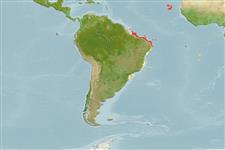>
Eupercaria/misc (Various families in series Eupercaria) >
Labridae (Wrasses) > Bodianinae
Etymology: Bodianus: Bodianus after Bodiano or Pudiano, from the Portuguese pudor, meaning modesty (Jordan & Evermann, 1896); insularis: Name derived from a Latin adjective meaning 'of an island'; in reference to the apparent restriction of this species to islands associated with the Mid-Atlantic Ridge (Ref. 75973).
Environment: milieu / climate zone / Tiefenbereich / distribution range
Ökologie
seewasser riff-verbunden; tiefenbereich 6 - 60 m (Ref. 58047). Tropical
Eastern Atlantic: St. Paul Rocks, Ascension and St. Helena.
Size / Gewicht / Alter
Geschlechtsreife: Lm ? range ? - ? cm
Max length : 33.0 cm TL Männchen/unbestimmt; (Ref. 3637)
Caught in areas of rock and rubble bottoms associated with sand or reef-like areas. Protogynous hermaphrodite, with obvious sexual dichromatism (Ref. 5292). Oviparous, distinct pairing during breeding (Ref. 205). Juveniles remove ectoparasites from other species (Ref. 86997).
Life cycle and mating behavior
Geschlechtsreife | Fortpflanzung | Ablaichen | Eier | Fecundity | Larven
Oviparous, distinct pairing during breeding (Ref. 205).
Gomon, M.F., 1981. Labridae. In W. Fischer, G. Bianchi and W.B. Scott (eds.) FAO species identification sheets for fishery purposes. Eastern Central Atlantic; fishing areas 34, 47 (in part). Department of Fisheries and Oceans Canada and FAO. Vol. 2. pag. var. (Ref. 3637)
IUCN Rote Liste Status (Ref. 130435: Version 2024-2)
Bedrohung für Menschen
Harmless
Nutzung durch Menschen
Fischereien: weniger kommerziell
Tools
Zusatzinformationen
Download XML
Internet Quellen
Estimates based on models
Preferred temperature (Ref.
123201): 26.1 - 27.6, mean 27.4 °C (based on 42 cells).
Phylogenetic diversity index (Ref.
82804): PD
50 = 0.5000 [Uniqueness, from 0.5 = low to 2.0 = high].
Bayesian length-weight: a=0.01230 (0.00569 - 0.02662), b=3.05 (2.87 - 3.23), in cm total length, based on LWR estimates for this Genus-body shape (Ref.
93245).
Trophic level (Ref.
69278): 3.5 ±0.5 se; based on size and trophs of closest relatives
Widerstandsfähigkeit (Ref.
120179): mittel, Verdopplung der Population dauert 1,4 - 4,4 Jahre. (Preliminary K or Fecundity.).
Fishing Vulnerability (Ref.
59153): Low vulnerability (23 of 100).
🛈
